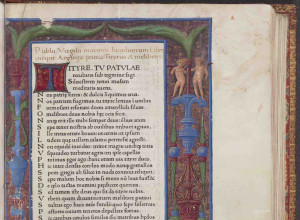Other manuscripts in the exhibition also reflect the richness of Jewish culture in France from the 13th to the 18th centuries. A special highlight will be the medieval Mahzor Vitry (1204) which is the earliest surviving record of the emerging practices of Ashkenazi Jewry, with prayers for the entire year and customs for life-cycle events.
In the early 18th century, a revival of luxurious Hebrew manuscripts emerged in the German-speaking lands of the Hapsburg Empire, blending traditional Jewish texts with contemporary European artistic styles. Representing this era will be a miniature manuscript of daily prayers (Vienna, 1724), depicting a woman seated in her bedroom with an open book for the Shema prayer, which is traditionally recited prior to retiring to bed.
In medieval times, Ashkenazi Jews of German lands created very large, illustrated prayer books to be used by the cantor of a synagogue, and the massive Esslingen Mahzor (Germany, 1290), a holiday prayer book for Rosh Hashanah and Yom Kippur, will be another highlight. A page on display depicts the opening words of a liturgical hymn recited on the first day of Rosh Hashanah, enclosed within a Gothic-style monumental arch.
Located at an important nexus in the trade routes that stretched from the Mediterranean to the Far East, Jews have lived in Yemen since antiquity. The exhibition will feature a 15th century Yemenite bible, written in a bold, square script on paper, rather than parchment. Decorated with stylized birds and geometric motifs, this manuscript reflects the artist’s adoption of the dominant Islamic visual culture, which eschewed figural art.
Jewish communities in Babylonia and Persia (modern-day Iraq and Iran) engaged with the artistic styles and intellectual traditions of the surrounding Islamic culture. This cultural exchange is evident in manuscripts merging Jewish themes with Persian aesthetics, such as Yusuf and Zulaykha (Iran, 1853), which reimagines the biblical tale of Joseph and the wife of Potiphar. On view in the exhibition will be folios showing Joseph being mistreated by his brothers and cast into a pit.
Jewish communities flourished for over a thousand years in the North African region known as the Maghreb, comprising Morocco, Algeria, Tunisia, and Libya. The exhibition will include a vividly decorated ketubbah, or marriage contract, from 1847 in which the text is framed within a Moorish arch, a popular motif influenced by the architectural milieu.
Many Sephardi Jews found refuge in the territories of the Ottoman Empire, and marriage contracts in the collection reflect the integration of Jewish ritual with the visual language of Ottoman art. A colorful ketubbah (1830) on view features a popular 19th century style in Constantinople, with crowded vegetation, flowers painted in bright colors without outlines, and gilt borders and inscriptions.
Knowledge of the Jews of Egypt was illuminated by the mid-19th century discovery of a remarkable cache of documents, known as the Cairo Genizah, in the Ben Ezra Synagogue in Old Cairo. A genizah is a repository that holds sacred Jewish texts no longer in use. The Cairo Genizah, however, included anything written in Hebrew letters, sacred or secular, more than 400,000 folios spanning more than a millennium of Jewish daily life. The Library of JTS holds the world’s second-largest collection of documents from the Cairo Genizah, and the exhibition showcases a fragment of an 11th century primer that demonstrates how children were taught the letters of the Hebrew alphabet.





















